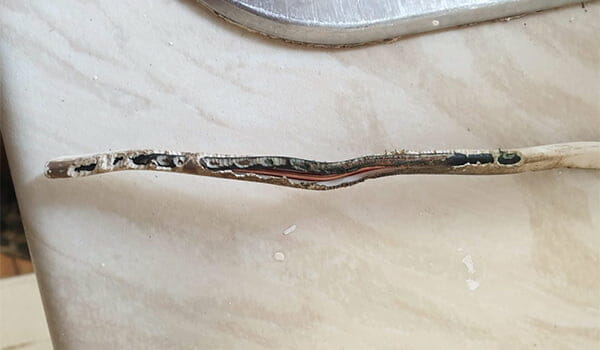Table of Contents
Why control House Mice?
Why should you worry about mice in your home is a question we often get asked. Many people own mice as pets, so why should you worry?
Well, house mice are known to spread horrible diseases to humans. Mice like to mark their territory with urine, which means that they are likely to spread conditions such as Salmonella and Listeria, which can cause food poisoning for humans.
Another reason why you should worry about mice in your home is that they have a compulsive need to gnaw. The need to chew is solely down to keep their incisor teeth worn to a suitable length. Unfortunately, for homeowners, this means electric cables, water pipes, gas pipes, packaging, and woodwork may all be seriously damaged by mice. Fires and floods have even been caused down to the gnawing behaviour of mice.

If you own a business rather than a home, it’s even more crucial to take steps to control mice. If your staff, customers or clients spot evidence of a mouse infestation, there is a high probability that they will not want to conduct business with you. Please visit our mouse pest control London page to learn more and book a treatment with an expert.
What do house mice look like?
The house mouse is tiny. The body of a house mouse can range between 60-90mm, they have four legs and are round in shape. Their tail is usually around the same size as the body so a 90mm house mice will have a tail of around 90mm.
If you ever get the chance to weigh one, you will find that they are roughly 25g.

A house mouse’s fur colour varies from grey to brown.
Trust us; if you have a mouse infestation, you’ll be able to smell something funny. Mice have a very distinct smell, and a large mouse infestation will not go unnoticed. Or unsmelled.
What do mice droppings look like?
From our experience, it can difficult at first to tell if you have mice or rat droppings. The main thing to notice is size. Mouse droppings are usually around 0.3cm to 0.6cm. The best tip we can give for identifying mouse droppings is to ask, do they look like dark grains of rice?

Characteristics of mice
Mice are entirely ahead of the game compared to humans when it comes to hearing. Using ultrasound to communicate means any sudden or unfamiliar noise will frighten them, making them extremely hard to catch in the act.
You will usually be able to notice that mice are in your home by their dark-coloured droppings or if you have seen the damage to food sources, packaging or woodwork. Mice and rats are often confused, learn more about what a rat vs mouse looks like.
Mouse habitat
As mentioned previously, a strong indicator that mice are in your home is that packaging or woodwork is damaged. Mice build nests out of material such as cloth, wool, wood and paper.
They typically build nests inside of houses, utilising areas such as roofs, under floors or in your wall. During the winter months, you are more likely to notice mice in your property as they look for warmth and shelter from the cold.
Furthermore, you are more likely to hear mice at night due to them being nocturnal. They often come out at this time and can be heard foraging as they search your home or kitchen for food.
Further down this article, we will share some mouse proofing tips to keep your home free from mice, but to put it in perspective, mice can squeeze through cracks as small as 5mm. So be prepared to block up the smallest of holes to stop your mouse problem.
What do mice eat?
Mice are erratic, sporadic feeders. Meaning that rather than taking repeated meals from one food source, they will nibble at many sources of food. So, to answer the question, mice will pretty much eat anything, but we have found that they tend to love cereal.
Moreover, mice do not need free water to drink as they will usually be able to gather enough from the food that they are consuming.
Signs of mice in your house
If you think mice might be in your home or business, then here are some common signs.
The main give away for house mice is their droppings. As mentioned previously, they are often black, rod-shaped and 3-6mm long. There will not be any shortage of droppings either; each mouse can leave approximately 80 droppings per day. We recommend looking under the kitchen sink, around central heating boilers and in roof spaces for droppings.
The next sign that mice are in your property is the dark grey marks they leave on surfaces. Mice carry lots of oils in their fur, and after repeated contact with surfaces, you will often see smear marks.
Nests also can be seen. Check lofts, under floorboards and in airing cupboards for nesting materials.
Finally, mice need to gnaw for their teeth. If you notice materials such as food, wood, carpets, paper, pipe cables, or furniture have damage to them, there is a good chance that mice are in your home.
Prevention is better than the cure
Preventing mice in your home should always be your first step. However, being proactive is hard if you don’t notice any problems with mice in your home, to begin with.
Remember that 5mm gap that mice need to fit through? Well, sealing any gaps around pipes and entry points to your home with wire wool in quick-setting cement should do the trick.
Mice tend to focus around the lower levels of your home, so we recommend putting all your focus into mouse proofing the ground level first. Once you have completed the ground level, it is then time to move higher up.
Just make sure to triple check the basement!
Do you have an overgrown garden? Keeping gardens clean is our next proactive tip. Cutting back any dense areas and clearing piles of wood and debris should help remove potential nesting areas for mice.
Finally, you should completely seal the rubbish and bins outside your home. House mice will be attracted to waste areas, and if they can gain access to it, they will keep coming back to your garden until they decide to venture into your home.
How to get rid of House Mice
If you have noticed mice in your home and want to get rid of them, it’s essential to follow all our steps. House mice are adaptable, mobile and breed rapidly. The combination of these three factors means that an untrained individual may struggle to solve the problem.
1. Pest proof their entry points
Probably the best method to stop mice in your home is to pest-proof the area. Mice need to gain access to the building somehow, and if you make it impossible for them to gain access, you’ll never have a mouse problem.
Search the outside of your home and find any small areas that a mouse would be able to gain access through as well as covering any pipes or regions inside your house that are small enough.
2. DIY pest control traps and poisons
You can always buy poisons and traps from online sites and garden centres. However, if you do decide to carry out the work yourself, you must learn more about the habits of mice, the correct baiting and trapping techniques to use as well as which combinations of rodenticides to use.
An alternative to using poisons are simple mouse traps. We would not recommend an untrained individual to use poisons, but we have found nutty chocolate, raisins or other similar foods to be extremely useful.
Just don’t use cheese, it’s comparatively poor mouse-bait compared to the above.

For mousetraps to be effective, they must be placed tight to walls and at a right angle. The reason for this is because mice can activate the treadle from either direction.
The final DIY tip we have for getting rid of mice using poison or traps is to make sure they are safe and secure. The last thing you want is for them to be in reach of children or pets!
3. Keep your garden tidy
Keeping the exterior of your home tidy is very important to stop mice venturing into your home, as this is where it starts. Mice like to use wood for nesting material, so make sure to keep piles of wood to a minimum.
A tidy garden is uninviting to house mice, so cut back from branches, bushes and grass.
4. Keep your home tidy
This one should seem obvious, but if you have a dirty home, mice will find it easy to survive. Don’t leave food sources out for mice to nibble on and make sure that if you do notice mice in your home, you seal all food in airtight containers.
Don’t forget pet food; if you leave dog food out overnight, there is a high chance that mice will be feeding on it.
5. Contact a pest control professional
We always recommend contacting a professional pest control company like Integrum Services to carry out the work. It might sound easy to get rid of mice in your home, but there is a reason you need to be a member of the BPCA to carry out this type of work.
Trained pest control technicians have access to a range of professional use rodenticides which are not available to the public and have years of knowledge and experience delivering pest control services. We’re available to help you get rid of mice in your home around the south-east of England and London.




